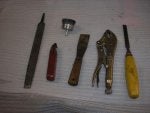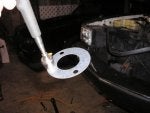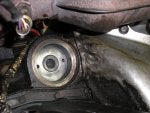Yours may be a post earlier where I volunteer that china walls are a million times more probable than rear main. I've posted pretty impressive pics of mine after it was just 10 years old and the 'funny yellow rtv' had pretty much vanished. So, I've got an even better sell; since the intake is a 'regular maint. item', then if you haven't done the intake in 10 years, --- (and even moreso if NEVER done since new) then it's overdo anyway. And when you have that PM thing out of your hair, and any other leak can stand on its own merit.
Yes I believe that was me. Not sure when the intake gasket was last done, but upon further inspection when I was doing the filter adapter, the back of the engine block did seem quite dirty but no signs of fresh oil. My guess is it was leaking then it got fixed but not cleaned.
If it continues to leak oil I will just do the intake and rear mains when I pull the engine for a rebuild.
Right now the engine is suddenly running awfully. Just cleaned and oiled my air filter, had the ac recharged, and did the filter adapter seals but even with the ac off it still runs like garbage so im ruling the AC out. I did spray all around the engine with brake cleaner to clean up the mess I made with AC compressor oil/dye. Maybe I ruined something by doing this?
On the way to get the AC system charged it seemed to run fine. It wasnt until about halfway home that it started to act up. Im hoping its the oxygen sensor connection since I had an issue with this after the filter adapter swap. Also the knock sensor wiring somehow became stripped off, so hopefully it's just shorting on something? I noticed this after I removed that metallic like tape during the oil filter adapter gasket swap since it was all about peeled off anyways and totally soaked in oil.
The check engine light is off for now.
I did find one plug wire that was not completely seated on the opti on the side of the engine that seems to have the issue (might be both though) but I haven't had a chance to see if this was the culprit. Based on how little the wire moved and that the issue started later in my drive, I doubt this wire is the issue. At idle the driver side exhaust has a periodic (but not on a perfect cycle) mild sputter. Under throttle in park it sounds normal. Under heavy throttle in gear it nearly bogs out and has awful acceleration and sounds terrible. Under light throttle it sputters pretty bad and bogs a bit and you can feel some surging.
Before I did the AC, oil filter adapter, and air filter, I recently (<500 miles) replaced the opti, I was getting code 36 and 42 which vanished after the opti swap. I used a cheapo amazon unit with 3 year warranty. Maybe it's dieing? It is super hot (nearly 100 F) today. I installed an MSD cap and rotor and applied RTV to all the seams and blue locktite to everything. I also did the opti and water pump seals in the timing cover, water pump, plugs, and wires at the same time. I used 10.5mm Busidin silicone wires off amazon and double platinum bosch plugs. It was running great after these repairs/swaps. Might make a new thread to address this. Sorry to hijack this one lol







